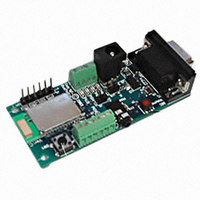BR-EVAL2.0 BlueRadios Inc, BR-EVAL2.0 Datasheet - Page 10

BR-EVAL2.0
Manufacturer Part Number
BR-EVAL2.0
Description
EVAL KIT BLUETOOTH VER2.0
Manufacturer
BlueRadios Inc
Type
Bluetooth V 2.0r
Datasheet
1.BR-EVAL2.0.pdf
(103 pages)
Specifications of BR-EVAL2.0
Frequency
2.4GHz
For Use With/related Products
Bluetooth
Lead Free Status / RoHS Status
Contains lead / RoHS non-compliant
Other names
822-1001
Page 10 of 103
BlueRadios, Inc.
Copyright © 2002-2008
BR-AT_COMMANDS-100 Rev. 3.6.2.1.4.0
Applications: The BlueRadios evaluation board can be used for both embedded and PC product applications.
It has a RS-232 DB-9 and J4 (0-3.3Vdc) direct UART interfaces to the module.
There are radio modem
input/output pins (PIO’s) connected to terminal lugs for applications that require external command and control.
The design incorporates a 13bit mono audio codec, jack, and MIC volume control for wireless headset applications
over SCO channel. The audio circuit has minimum filtering for noise, etc.
Pico-Nets: For applications that require more than point-to-point (2) devices communicating simultaneously – this
is called a pico-net.
These applications require one of the Bluetooth devices to manage all the network
connections. Because of hardware restrictions, the BlueRadios module supports up to 4 remote slave/master
connections and each channel connection status is output to a dedicated PIO pin.
Note: AT Command interface protocol is not used for the USB Bluetooth communicator. The stack for this resides
on the PC side not embedded in the unit like the serial SMT BlueRadios modules.
Making a Connection
Serial Interface
UART_TX, UART_RX, UART_RTS and UART_CTS form a conventional asynchronous serial data port. The
interface is designed to operate correctly when connected to other UART devices such as the 16550A. The
signaling levels are nominal 0V and 3.3V and are inverted with respect to the signaling on an RS232 cable.
The interface is programmable. The default condition on power-up is pre-assigned in the external 8Mb Flash.
Two-way hardware flow control is implemented by UART_RTS and UART_CTS. UART_RTS is an output and
is active low. UART_CTS is an input and is active low. These signals operate according to normal industry
convention.
BlueRadios shows up under Service discovery defaulted as Serial Port Profile (SPP) Service “COM0, COM1,
COM2, and COM3 on BlueRadios”, where COMX is the arbitrary service name and BlueRadios is the local device
name. All of these name settings are configurable by the user.
To connect to BlueRadios, browse for services, you should see: “BlueRadios “Serial Port” as the Profile.
BlueRadios uses SPP as default, and will be connected to a Virtual COM port on PCs, Palm Pilot’s, PocketPCs,
or other clients.
Once connected, the Bluetooth address for each device is exchanged with the message
CONNECT, displayed, and data will flow in both directions in regular data mode as if the serial port were locally
attached. AT commands can be sent directly to the radios UART when not Bluetooth connected or by any remote
Bluetooth RF device connection after typing +++ followed by a carriage return. The +++ is the factory default
escape sequence to place the radio in command mode when there is a Bluetooth RF connection. The Slave
radios UART will respond automatically with DISCONNECT {in point-to-point mode} or DISCONNECT,00 {in multi-
point mode} when it is disconnected from Channel 00 for example. This verbalization response can be changed
to short/long or none if preferred using ATSW24 power up default settings.
BlueRadios Class1 Bluetooth device with a high power transceiver (100meters/330 feet) or (10 meters/33 feet) for
Class2 performance, however; actual range may vary due to environment, type of antenna, board layout,
enclosure design or type of client device used to connect to BlueRadios. We have an AT Command to control
and set the maximum RF output power.
Note: Only one device can make connection to BlueRadios at a time, and there is a limit of 8 simultaneous
communicating devices in a Bluetooth pico-net network.
rd
BlueRadios Evaluation Board Physical Ports (3
Generation)
•
•
•
7173 S. Havana Street, Suite 600
Englewood, CO 80112
Tel (303) 957-1003
sales@BlueRadios.com
www.BlueRadios.com























